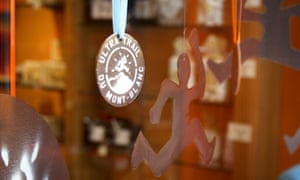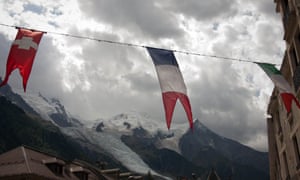“The Tour du Mont Blanc? I walked that a few years ago and it took me 10 days. You’re running it in one go? You’re joking!” This is what people usually say when you tell them you’re going to do a race around Mont Blanc.
To the non-runner, it seems a bit unlikely that people should do this sort of thing for fun. But for many runners, the Ultra-Trail du Mont-Blanc (UTMB) has iconic status, appearing on countless bucket lists. There are longer races and those with more elevation (Italy’s Tor des Geants is 330km long with 24,000m of ascent); courses with more difficult conditions (Badwater, in Death Valley, USA, takes place in temperatures of over 50C); and running events that go on for longer (Morocco’s Marathon des Sables takes six days). But the UTMB has something particularly special about it, with a distinct cachet for ultra runners.
The Ultra-Trail du Mont-Blanc event actually offers six races: the UTMB, the Traces des Ducs de Savoie (119km, including 7,250m of elevation), the Courmayeur-Champex-Chamonix (101km, with 6,100m), the Orsieres-Champex-Chamonix (53km, with 3,300m) that was started in 2014, the Petite Trotte à Léon (300km, with 28,000m uphill, to be completed in teams and unsupported) and the new Youth Chamonix Courmayeur (15km including 1,100m) for 16- to 19-year-olds. So there is scope to do one of the smaller races – although the fact that a race of 101km with 6,100m of ascent is classed as “smaller” should serve as a warning sign about the event. All of these courses are very difficult; they are to be respected, and that’s what makes completing them so satisfying.
Even getting into the UTMB involves a degree of hardship. Entrants for the 2015 race had to acquire eight qualification points from a maximum of three races in order to even enter the draw (for 2016 this is increasing to nine points). As an example, completing the South Downs Way 100 race (100 miles in one go from Winchester to Eastbourne) would give you four; The Pennine Spine Race (a brutal 268 miles of the Pennine Way, in January) is also worth four; the Lakeland 50 will net you two points; and many of the more flat 50-mile events will only get you one. So everyone on that start line has completed some very tough races. There are no blaggers here.

To arrive in Chamonix, where the race starts and finishes, during race week is to arrive in a runners’ wonderland. The whole town is taken over with this event: excitement, trepidation and a whiff of Deep Heat are in the air. The gods of the sport move among us – you might bump into Timothy Olsen, Rory Bosio, Anna Frost or Kilian Jornet walking through town – elite sportspeople, but runners with exactly the same doubts and fears as you. Even the shops that have no connection with running manage to find one during UTMB week: chocolatiers make special chocolate medallions with the UTMB logo and chemists make window displays out of knee supports, blister plasters and painkillers. For one week only, Chamonix plays host to the World Cup of ultra running.
The course itself has to be one of the most breathtaking settings for a race in the world. You run in the shadow of Mont Blanc, you reach 10 summits, you cross rivers, glaciers and you run in three countries. Three countries! Now that’s a long run. Most participants will run through two nights, which means they’ll get to see the sun rise over the range twice in one race. Not many people get to experience that in a lifetime. Mont Blanc itself is a symbol for human endeavour: known as one of the most deadly mountains in the world, its scale and difficulty has fascinated adventurers throughout history. Having it as a backdrop throughout the race serves as a reminder that you are following in these footsteps.
The scale of almost everything about this contest is hard to comprehend. Not only will runners scale a height greater than Everest during their runs, they will also ingest 300kg of cheese and 15,000 litres of cola. Along the way, they’ll encounter 15,000 way markers (it’s fully signposted, unlike many UK trail races) and 2,000 volunteers at the 53 control points and 38 refreshment posts (across the six races).

But if this is starting to sound a bit controlled and tame, perhaps the completion statistics will restore that sentiment of ‘oh actually this is quite hard’. The first UTMB race in 2003 attracted 722 runners, only 67 of whom finished. The odds are much better now but typically still only around 40% finish, compared with 98-99% in the London Marathon. Particular challenges include the terrain (rocky, sometimes technical, steep, and tough on the legs on the long descents), the weather (it can be bright sunshine and 25 degrees or blowing a gale and sub-zero) and the lack of sleep. It starts at 6pm, so you soon get to that first night and while the quicker runners (the winners finish in 20–21 hours) will finish the following afternoon, the majority will endure two nights without sleep. This does all sorts of strange things to your mind. Last year I experienced a hallucination of a centaur with the head of George Michael.
But nothing quite compares to the feeling of being a finisher. As you run through Chamonix centre, the streets are lined with people shouting ‘courage!’ and ‘allez, allez!’ and ringing cowbells – whether you finish in 21 hours or 46 (the cut-off). Every single runner is made to feel like they’ve won the Olympics. Finishers are awarded the coveted finisher’s gilet, which you wear with pride as you hobble through Chamonix exchanging respectful nods with other gilet-wearers. Every single contestant has been on a personal journey and pushed themselves to their absolute limit, and those nods acknowledge that shared experience. The start and finish is soundtracked by Vangelis’s Conquest of Paradise, played on loudspeakers throughout the town. Anybody who has completed any of the UTMB races is conditioned to spontaneously burst into tears upon hearing that song.
In a sport often obsessed with times, the UTMB offers a different type of challenge: you versus those mountains. You aren’t so much competing against the other runners, in fact, there is a huge mutual respect between all of the competitors. Even at the front end of the field, runners will buddy up to face the challenge together. Kilian Jornet has been known to wait for other people so he has company on the way and last year, two Spanish runners (Iker Karrera Aranburu and Tòfol Castanyer Bernat) finished joint-second, because they couldn’t contemplate racing each other at the end after supporting one another for half of the race. This event humbles you, leaving no room for egos.
Lizzy Hawker, five-times winner of the women’s race and all-round inspiration to many, sums up the feeling the UTMB evokes in runners perfectly in her book, Runner: a Short Story About a Long Run: “I stare at the mountains towering far above us, and feel incredibly small. I have an overwhelming sense of my own insignificance. What is it that I’m doing? Whatever pain, doubt, hope, joy that I feel in the hours ahead, who will care, who will even know? At the same time it is as though the world is before us and full of infinite possibility.”
This year’s UTMB events will take place from 24 to 30 August.
www.ultratrailmb.com
Source: Read Full Article
